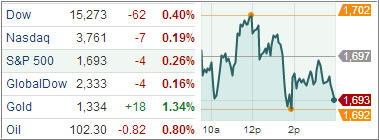Domestic equity markets fell today and the S&P 500 put in a fifth day of losses, its longest losing streak since the end of 2012, following some diverging domestic economic reports. Including today’s decline, the benchmark index has surrendered 1.9% since last Thursday.
Treasuries were higher amid the U.S. fiscal uncertainty and after durable goods orders came in mixed, offsetting a slightly higher rate of new home sales and a solid increase in mortgage applications. Investors worried about two looming Washington deadlines: prior to October 1 Congress needs to pass stop-gap funding for federal agencies and by October 17 it must raise the federal borrowing limit to avoid a debt default by the United States.
After opening just above its flat line, the S&P 500 slipped into the red before recovering swiftly with the help of energy (-0.1%) and materials (+0.2%). The financial sector (+0.5%) also fueled this morning’s rebound after losing roughly 3.5% during the past four sessions. The morning recovery placed the S&P above 1,700, but the index could not muster additional strength as consumer staples (-0.8%), health care (-0.8%), technology (-0.3%), and utilities (-0.7%) weighed.
Shares of Wal-Mart, the world’s largest retailer, added to early afternoon losses on the Dow and S&P 500 after a report by Bloomberg News that Wal-Mart was cutting orders to its suppliers for this quarter and next. The stock retraced some of its losses after the company called the report inaccurate and ended down 1.5 percent. Concerns about lackluster sales at the largest retailer were received as a warning regarding the well-being of the broader sector, causing other retailers like Costco, Dollar General, and Target to slump to their lows.
A report from the Commerce Department today indicated purchases of new homes rose in August, capping the weakest two months this year, showing the fallout from mortgage rates at a two-year high is cooling the real-estate rebound. Demand slumped 14 percent in July.
In a separate report, data showed orders for long-lasting U.S. manufactured goods barely grew in August in a possible sign that companies are holding back on investment spending.
Our Trend Tracking Indexes (TTIs) headed slightly lower and closed at +3.33% (Domestic TTI) and +7.31% (International TTI).
Contact Ulli
